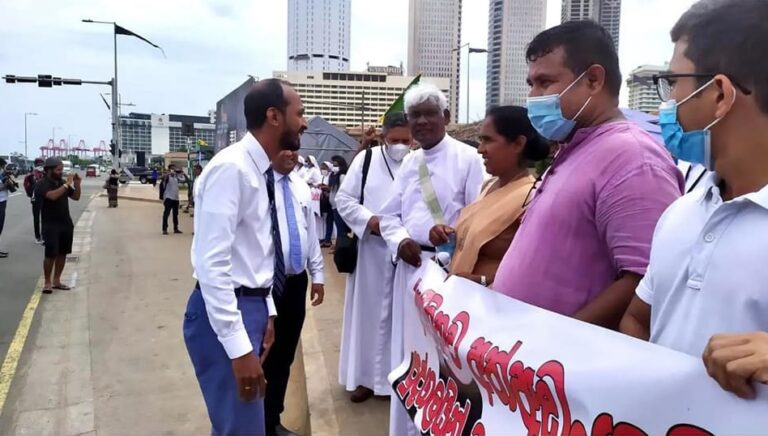Fitch Ratings said it was keeping a Rating Watch negative on Sri Lanka’s DFCC Bank amid a currency crisis that has triggered dollar shortages and sovereign default while there are also mounting bad loans.
The Rating Watch Negative “reflects the potential for the bank’s creditworthiness to deteriorate relative to other entities on our Sri Lankan national rating scale,” Fitch said.
“This is because of heightened stress on the bank’s funding and liquidity, and its exposure to the sovereign via investment in foreign-currency instruments that raise risks to its overall credit profile.
“We believe that the sharp rise in inflation, depreciation of the local currency, and other factors can distort the bank’s underlying financial position in the current operating environment.”
Sri Lanka is gripped by the worst currency crisis in the history of the island’s intermediate regime central bank. Sri Lanka’s economists got the ability to trigger a balance of payments deficits and currency crises with the setting up of a soft-pegged central bank in 1950.
In 2022 the rupee collapsed to 360 to the US dollar from 200 as an attempt was made to float the currency with a surrender rule.
Fitch said the bank’s foreign-currency funding and liquidity position was significantly challenged and vulnerable to sudden shocks amid weaker credit sentiment though the bank was successful in securing USD150 million of term funding in 2021, Fitch said.
“We believe further access to such funding would be difficult, similarly to peers, given the sovereign’s debilitated credit profile,” the agency said.
As customer repayment capacity weakens due to the economic conditions Fitch said, it expects DFCC’s impaired (stage 3) loan ratio to increase in the near to medium term.
” Impaired loans at end-2021 were 6.2% of total assets together with a further 2.2% of assets in US dollar-denominated sovereign bonds and Sri Lanka Development bonds, the share of which is estimated to have reduced in 1H22,” the rating agency said.
The agency said that sovereign default together with increasing economic challenges poses significant downside risks to DFCC’s profitability, to the extent that the bank may become structurally unprofitable.
“Earnings pressure is already evident in the bank’s operating profit/risk-weighted asset ratio that declined to 0.6% by end-1Q22 (end-2021: 1.7%) as credit costs eroded 83% of the bank’s pre- impairment profits”
The full statement is reproduced below:
Fitch Maintains DFCC Bank’s National Rating of ‘A+(lka)’ on Watch Negative
Fitch Ratings – Colombo – 28 Jul 2022: Fitch Ratings has maintained DFCC Bank PLC’s National Long-Term Rating of ‘A+(lka)’ on Rating Watch Negative (RWN). Fitch has also maintained DFCC’s senior and subordinated debt ratings of ‘A+(lka)’ and ‘A-(lka)’, respectively, on RWN.
KEY RATING DRIVERS
RWN Maintained: The RWN on DFCC’s National Long-Term Rating reflects the potential for the bank’s creditworthiness to deteriorate relative to other entities on our Sri Lankan national rating scale. This is because of heightened stress on the bank’s funding and liquidity, and its exposure to the sovereign via investment in foreign-currency instruments that raise risks to its overall credit profile.
We believe that the sharp rise in inflation, depreciation of the local currency, and other factors can distort the bank’s underlying financial position in the current operating environment.
Foreign Currency Liquidity Constraints: We believe DFCC’s foreign-currency funding and liquidity position is significantly challenged and vulnerable to sudden shocks amid weaker credit sentiment. The bank was successful in securing USD150 million of term funding in 2021, but we believe further access to such funding would be difficult, similarly to peers, given the sovereign’s debilitated credit profile.
Weakening Operating Environment: Our assessment of Sri Lankan banks’ operating environment (OE) reflects the pressure on the banks’ already stressed credit profile following the sovereign’s default on its foreign-currency obligations. It also captures the rapid deterioration in the broader economy, including increased interest rates, high inflation, and acute currency depreciation. The economic slump has limited DFCC’s operational flexibility.
Increasing Asset-Quality Pressure: Fitch expects DFCC’s impaired (stage 3) loans ratio to increase in the near to medium term as borrower repayment capacity weakens due to the rapidly deteriorating economic conditions. The bank’s exposure to the government’s foreign currency-denominated instruments, although small relative to peers, adds to asset-quality pressure. Impaired loans at end-2021 were 6.2% of total assets together with a further 2.2% of assets in US dollar-denominated sovereign bonds and Sri Lanka Development bonds, the share of which is estimated to have reduced in 1H22.
Capital Buffers Under Pressure: Fitch expects increased asset-quality risks, and weaker earnings retention alongside bloated risk-weighted assets from the Sri Lankan rupee’s sustained depreciation, which will exert significant pressure on the bank’s capitalisation metrics in the near term. This is despite the bank’s lower exposure to foreign currency-denominated government securities than that of peers. Capital raising continues to be a challenge for the bank, as seen in its recently concluded rights issue that was undersubscribed.
Credit Costs to Erode Earnings: We believe that sovereign default together with increasing economic challenges poses significant downside risks to DFCC’s profitability, to the extent that the bank may become structurally unprofitable. Earnings pressure is already evident in the bank’s operating profit/risk-weighted asset ratio that declined to0.6% by end-1Q22 (end-2021: 1.7%) as credit costs eroded 83% of the bank’s pre-impairment profits.
Economic Volatility Weighs on Business Model: We believe that DFCC’s business profile, like most domestic peers, is highly vulnerable to the intensifying risks in the domestic market, given the high concentration of its business profile on the weak and unstable Sri Lankan economy. This could limit the bank’s ability to generate and defend business volume. The rapidly deteriorating OE is likely to derail the bank’s aspiration of reaching LKR1 trillion asset base by 2025.
High-Risk Profile: DFCC’s elevated risk profile, similar to local peers, stems from its main exposure to high-risk customer segments with weak credit quality, as reflected in the ‘ccc’/negative OE.
This is further exacerbated by DFCC’s exposure to the government’s foreign currency-denominated instruments, albeit lower relative to peers, making the bank vulnerable to the sovereign’s repayment capacity and liquidity position.
RATING SENSITIVITIES
Factors that could, individually or collectively, lead to negative rating action/downgrade:
The RWN reflects rising risks to the bank’s rating from funding stresses, which could lead to a multiple-notch downgrade. We expect to resolve the RWN when the impact on the issuer’s credit profile becomes more apparent, which may take more than six months.
Developments that could lead to a multiple-notch downgrade include:
– funding stress that impedes DFCC’s repayment ability;
– significant banking-sector intervention by authorities that constrains the bank’s ability to service its obligations;
– a temporary negotiated waiver or standstill agreement following a payment default on a material financial obligation;
– Fitch’s belief is that DFCC has entered into a grace or cure period following non-payment of a material financial obligation.
A downgrade of the sovereign’s Long-Term Local-Currency Issuer Default Rating (CCC)could also lead to a downgrade of the bank’s rating.
Factors that could, individually or collectively, lead to positive rating action/upgrade:
There is limited scope for upward rating action given the RWN
OTHER DEBT AND ISSUER RATINGS: KEY RATING DRIVERS
SENIOR DEBT
DFCC’s outstanding senior unsecured debentures are rated at the same level as its National Long-Term Rating under Fitch’s criteria. This is because the debt ranks equally with the claims of the bank’s other senior unsecured creditors.
SUBORDINATED DEBT
DFCC’s Basel II- and Basel III-compliant Sri Lankan rupee subordinated debt is rated two notches below the National Long-Term Rating anchor. This reflects Fitch’s baseline notching for loss severity for this type of debt and our expectations of poor recoveries.
There is no additional notching for non-performance risks, as the notes do not incorporate going-concern loss-absorption features.
OTHER DEBT AND ISSUER RATINGS: RATING SENSITIVITIES
The senior and subordinated debt ratings will move in tandem with the bank’s National Long-Term Rating.
Source: Economy Next











